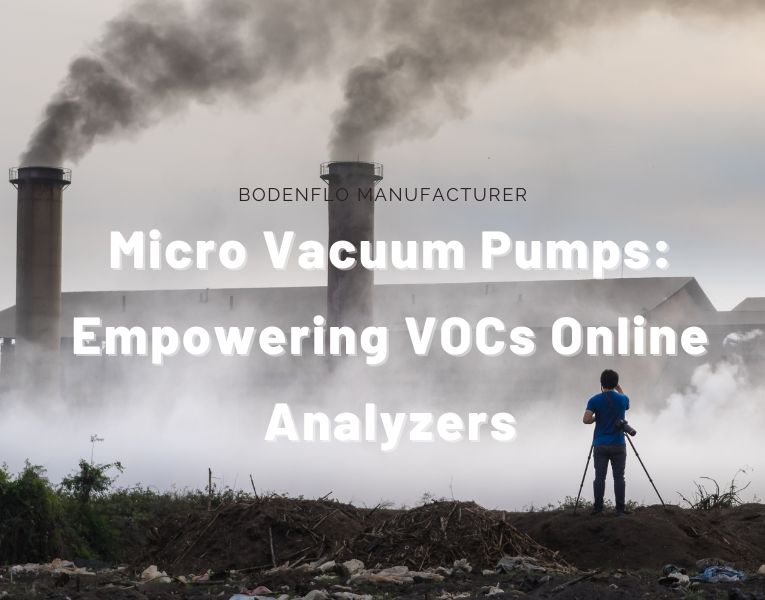
In my role as a product manager at BODENFLO, where we specialize in miniature pump technologies, I have seen the substantial impact that micro vacuum pumps have had on the field of air quality monitoring, particularly in VOCs (Volatile Organic Compounds) Online Analyzers. This article aims to delve into the specifics of how these pumps function and why they are indispensable in such analyzers.
Micro vacuum pumps are critical components in VOCs analyzers. Their role is to provide the necessary vacuum for consistent and accurate sampling of air, which is essential for the reliable detection and analysis of VOCs. The integration of these pumps into VOCs online analyzers is a blend of engineering precision and a deep understanding of environmental monitoring requirements.
The careful selection of the right micro vacuum pump for a VOCs analyzer is more than a technical challenge; it's a strategic decision that significantly affects the efficiency and accuracy of air quality monitoring.
How does a micro vacuum pump work in small and portable VOC analyzer?
In a portable VOC analyzer, the role of a micro vacuum pump is both critical and multifaceted. Understanding how these pumps function within the system sheds light on their significance in enhancing the analyzer's overall performance:
- Air Sampling Mechanism: The primary function of the micro vacuum pump in a portable VOC analyzer is to draw air samples into the device. It creates a controlled vacuum, ensuring a consistent and precise flow of air through the analyzer’s sensors. This consistent flow is crucial for accurate VOC detection and quantification.
- Maintaining Steady Vacuum Levels: For effective VOC analysis, it’s essential to maintain steady vacuum levels. The micro vacuum pump does this by adjusting its operation based on the analyzer's requirements. This adaptability is vital, especially in field conditions where environmental factors can affect air sampling.
- Energy Efficiency: Portable VOC analyzers often rely on battery power, making energy efficiency a key concern. Micro vacuum pumps are designed to consume minimal power, thus preserving the analyzer's battery life while maintaining optimal functionality. This efficiency is crucial for extended field operations where recharging opportunities may be limited.
- Integration with Control Systems: In advanced portable VOC analyzers, micro vacuum pumps are integrated with digital control systems. This integration allows for precise control over the pump's operation, including start-stop cycles and flow rate adjustments, based on real-time data from the analyzer’s sensors.
- Compact and Quiet Operation: The small footprint of the micro vacuum pump is essential in portable devices, where space is at a premium. Additionally, their quiet operation is beneficial in scenarios where noise minimization is crucial, such as in indoor air quality assessments.
- Reliability in Diverse Conditions: Given that portable VOC analyzers are used in a variety of environments, from industrial sites to urban settings, the micro vacuum pump must be reliable under diverse conditions. Its robust design ensures consistent performance, regardless of external factors like temperature fluctuations or varying air pressure.
In conclusion, a micro vacuum pump in a portable VOC analyzer is a key component that drives the device's efficiency, accuracy, and versatility. Its ability to provide precise air sampling, coupled with its energy efficiency and adaptability to different environments, makes it an indispensable part of portable VOC monitoring technology.
Which Micro Vacuum Pump is Best for Your VOCs Analyzer?
When it comes to choosing the right miniature vacuum pumps for VOCs (Volatile Organic Compounds) analyzers, understanding the specific requirements of your application is key. The type of VOCs being monitored, the required sensitivity of detection, and the operational environment play crucial roles in determining the most suitable pump:
- Diaphragm Micro Vacuum Pumps: These are optimal for applications where low to medium flow rates are needed, and minimal noise and vibration are essential. They operate oil-free, ensuring that air samples remain uncontaminated, a critical factor in accurate VOCs analysis.
- Rotary Vane Micro Vacuum Pumps: These pumps are more appropriate for scenarios that demand higher vacuum levels. Although generally noisier and larger than diaphragm pumps, their robust design provides the necessary power for comprehensive VOCs detection, especially in more demanding environments.
- Piezoelectric Micro Pumps: For ultra-compact analyzers or those requiring very low flow rates, piezoelectric micro pumps are an ideal choice. They offer unparalleled precision in flow control, making them perfect for analyzers designed to detect trace levels of VOCs.
The selection of the pump hinges on balancing these various factors, ensuring that the chosen pump aligns perfectly with the specific needs of your VOCs analyzer. Each pump type brings its unique strengths to the table, and the decision should be tailored to the specific demands of your VOCs monitoring tasks.
What's The Working Principle and Structure of Micro Diaphragm Vacuum Pumps?
Understanding the working principle and structure of micro diaphragm vacuum pumps is crucial to appreciate their role in VOCs analyzers:
- Diaphragm: The core of these pumps is a flexible diaphragm, usually made of materials like PTFE or EPDM, known for their chemical resistance and durability. The diaphragm's movement creates the vacuum necessary for air sampling.
- Chamber and Valves: The pump chamber is divided into two parts by the diaphragm. As the diaphragm moves up, it creates a vacuum, drawing air in through the inlet valve. When it moves down, the air is expelled through the outlet valve.
- Motor and Mechanism: The diaphragm is actuated by an electric motor, often through a connecting rod. This motor's rotation is transformed into the up-and-down movement of the diaphragm.
- Design Advantages: This design offers low power consumption, quiet operation, and the ability to provide a consistent and controllable flow rate, all crucial for VOCs analysis. The oil-free nature of the pump ensures that the air samples remain uncontaminated.
The micro diaphragm vacuum pump's design is a perfect fit for portable VOCs analyzers where size, efficiency, and reliability are key.
How to choose the right micro vacuum pump?
Choosing the right micro vacuum pump for your application, particularly in sophisticated devices like VOCs analyzers, requires a detailed understanding of several key factors:
- Flow Rate Requirements: Assess the required flow rate for your application. For tasks needing precise control, such as in laboratory settings or medical devices, opt for pumps like diaphragm or piezoelectric types that offer better flow rate control.
- Vacuum Level: Determine the vacuum strength needed. If your application demands high vacuum levels, such as in certain industrial or environmental monitoring scenarios, rotary vane micro pumps might be more suitable.
- Size and Portability: For portable devices, the pump’s size and weight are critical. Micro diaphragm and piezoelectric pumps, known for their compact designs, are often favored in handheld or field-based equipment.
- Power Consumption: Evaluate the power availability and consumption. In battery-operated or energy-sensitive applications, pumps with low power consumption like coreless diaphragm pumps are advantageous.
- Operational Environment: Consider the environmental conditions where the pump will be used. Pumps need to be robust enough to handle the operational stresses, whether they are temperature variations, potential exposure to chemicals, or mechanical vibrations.
- Noise Level: In settings where noise is a concern, such as in medical or indoor air quality monitoring applications, choose pumps that operate quietly.
- Material Compatibility: Ensure that the pump materials are compatible with the media they will encounter, especially important in applications involving corrosive substances or extreme temperatures.
- Maintenance and Longevity: Consider the maintenance needs and expected lifespan of the pump. Opt for pumps that offer durability and ease of maintenance to reduce long-term operational costs.
In essence, selecting the right micro vacuum pump is about aligning these technical specifications with your application’s unique requirements. At BODENFLO, we specialize in providing expert guidance to help you navigate these choices, ensuring you select a pump that perfectly meets your needs.
Conclusion
In conclusion, micro vacuum pumps are integral to the efficacy of VOCs analyzers. Careful selection and understanding of their functionality ensure accurate environmental monitoring. For tailored solutions that meet your specific VOCs analysis needs, consult with us at BODENFLO, where expertise meets innovation.
Related Article:
What Is An Air Sample Vacuum Pump?
Air Sample Vacuum Pumps: The Backbone Of Efficient Air Sampling Equipment
Customizable Micro Vacuum Pumps: Tailoring Solutions To Your Needs


